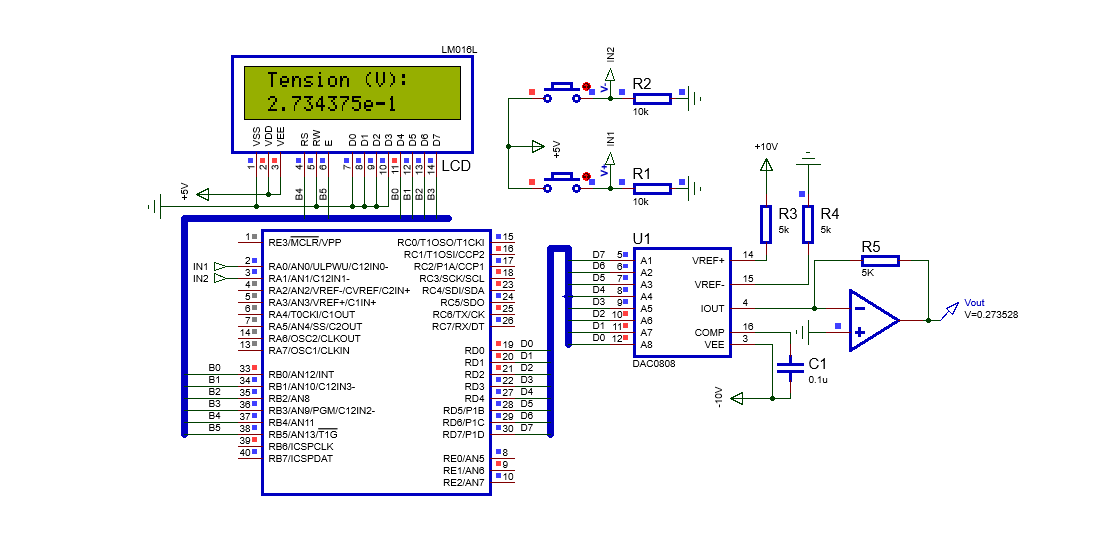Objectifs
- Savoir l’utilité d’un convertisseur Numérique Analogique (DAC)
- Connaitre les caractéristiques du DAC0808
- Savoir réaliser une source de tension numérique
- Savoir utiliser un LCD avec MikroC
- Connaitre les caractéristiques du LCD LM016L 16×2
- Savoir utiliser quelques fonctions de conversions de types
- Comprendre le fonctionnement d’un amplificateur de transimpédance
- Et autres astuces pratiques
Applications
- Source de tension précise
- Générateur des signaux
- Asservissement des moteurs
Fonctionnement partie matérielle
Principe
L’objectif du projet est de concevoir une source de tension numérique précise dont la tension peut varier entre 0 et une valeur maximale. Nous disposons de deux boutons poussoirs permettant d’incrémenter ou décrémenter la tension de sortie d’un pas ajustable dans le programme. Le convertisseur numérique-analogique est l’élément essentiel dans notre montage. Il sert à convertir une valeur numérique sur 8 bits à une grandeur analogique (courant ou tension). La valeur de la tension de sortie sera ensuite affichée dans l’afficheur LCD en format flottant.
Convertisseur N/A DAC
Le DAC0808 est un convertisseur numérique analogique (DAC) monolithique de 8 bits offrant un temps de stabilisation du courant de sortie à pleine échelle de 150 ns en ne dissipant que 33 mW avec des alimentations de ± 5V. Aucun ajustement du courant de référence (IREF) n’est requis pour la plupart des applications puisque le courant de sortie à pleine échelle est typiquement ± 1LSB de 255= IREF / 256. La précision est de l’ordre de ± 0,19% assurent une bonne linéarité sur 8 bits pour IREF≥2 mA. Le courant d’alimentation du Le DAC0808 est indépendant du mot binaire, il présente des caractéristiques essentiellement constantes sur toute la plage de tension. De plus, le DAC0808 s’interface directement avec les protocoles TTL, DTL ou Niveaux logiques CMOS et remplace directement le MC1508 / MC1408 pour les applications à plus grande vitesse. Ci-dessous les caractéristiques essentielles du DAC :
- Résolution binaire : 8 bits
- Erreur de linéarité maximale de ± 0,19%
- Correspondance du courant en pleine échelle: ± 1 type LSB
- Temps de réponse : 150 ns typique (6.66 MHz)
- Compatible avec les entrées numériques: TTL et CMOS
- Vitesse de balayage d’entrée multiplicatrice à grande vitesse (Slew Rate): 8 mA / µs
- Gamme de tension d’alimentation: ± 4,5V à ± 18V
- Faible consommation d’énergie: 33 mW @ ± 5V
- Plus de détails: Datasheet DAC0808
Comment calculer le courant de sortie du DAC ?

On considère le montage ci-dessous (voir la page 8 du datasheet) utilisé par le constructeur pour faire ses tests. Le courant de sortie I0 d’après l’équation dépend de la tension de référence Vref fixée par l’utilisateur et la résistance R14 et l’état des bits d’entrées A1 (poids fort) à A8 (poids faible). Par conséquent la valeur LSB (la valeur la plus que peut prendre le courant I0) est égale au courant I0 lorsque le bit A8 est égal à « 1 ». On considère une tension Vref=10V, R14=5k. Alors le courant I0_LSB=(10/5000)*(1/256)= 7.8125E-6A=7.8125µA. Cette valeur nous sera intégrer dans le programme afin de calculer le courant I0 quelque soit l’état des bits A1-A8.
La résistance liée à la broche 15 permets de compenser en température le courant de polarisation, elle n’est pas nécessaire pour la plupart des applications.
Amplificateur de trans-impédance
Un amplificateur de trans-impédance est un convertisseur courant (I)/ tension (Vout). Il est constitué d’un amplificateur AOP et une résistance R (voir le montage ci-dessous). Le courant parcouru par la résistance R est égal au courant à l’entrée I. On a :
V(-)=Vout+R*I, V(+)=V(-)=0 ==> Vout=-RI
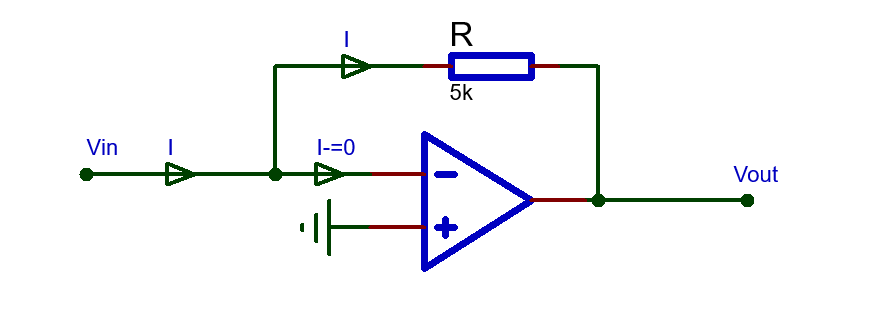
Le courant de sortie du convertisseur DAC I0=I14 (voir le datasheet) a un sens opposé à celui de l’amplificateur à transimpédance. Alors Vout=-(-RI)=RI. Par conséquent, la tension de sortie Vout est positive ou nulle en fonction de l’état des bits A1-A8.
Comment valider le fonctionnement du DAC ?
Il est important de faire correspondre les résultats théoriques et ceux de la simulation. En effet, on a besoin de vérifier si le courant LSB correspond parfaitement à la valeur obtenue par le calcul théorique I0_LSB=.7.8125µA. La méthode consiste à positionner le bit A8 à « 1 », et à 0 les autres bits : A1-A7= « 0000000 » puis utiliser la résistance R5 d’une valeur égale à 1 Ohm (Vout=R5*I0=I0). Ci-dessous le résultat de simulation :
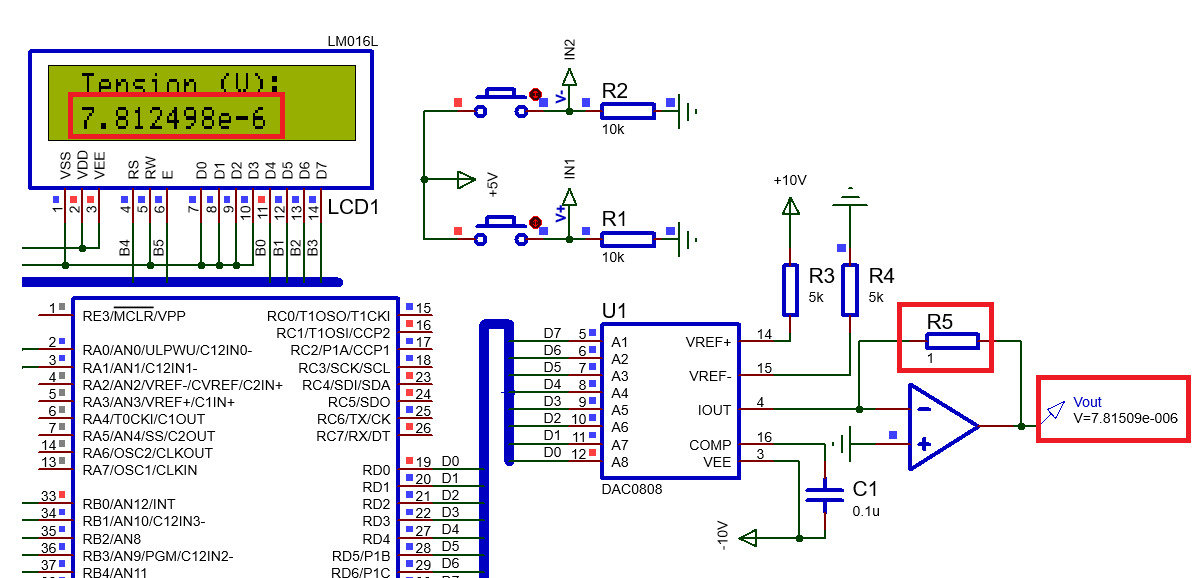
Le résultat de simulation correspond parfaitement à la valeur calculée du courant I0_LSB (A8=1)
Alors: Vout=R5*I0
Valeur maximale: MSB
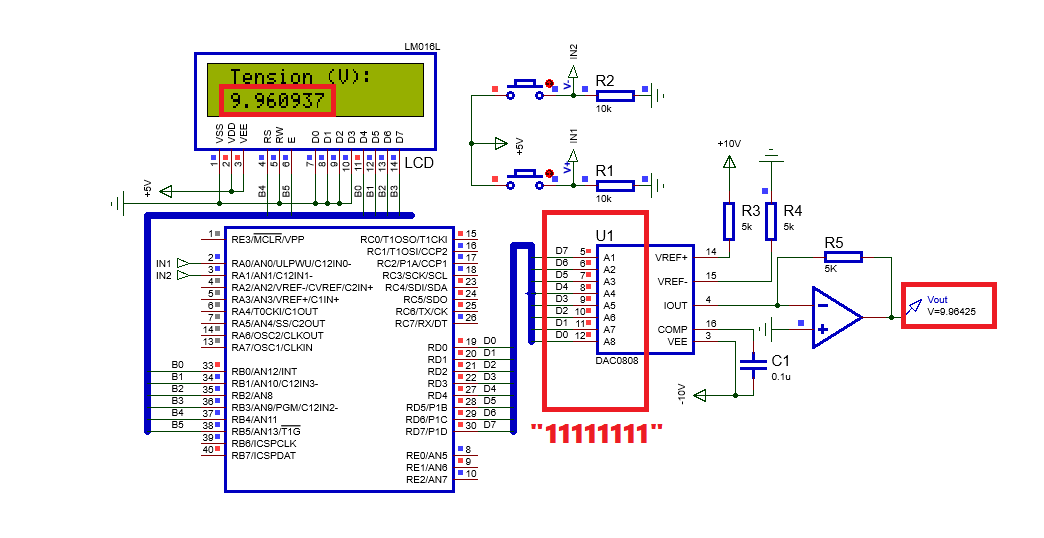
Afficheur LCD 12×2 LM016L (Caractéristiques)
Les écrans à cristaux liquides à base de caractères ils sont couramment utilisés. Ils sont basés sur le contrôleur HD44780 d’Hitachi ou autres, compatibles avec le HD44580. Nous abordons dans la suite les différents pins de l’afficheur, de son interface avec le microcontrôleur PIC18F887 en utilisant la commande 4 bits par l’intermédiaire d’un ensemble des fonctions MikroC. Le LM016L est constitué de deux lignes (1) et (2), chaque ligne est peut contenir 16 caractères (numérotation : 1-16). Lire la suite Datasheet LM016L.
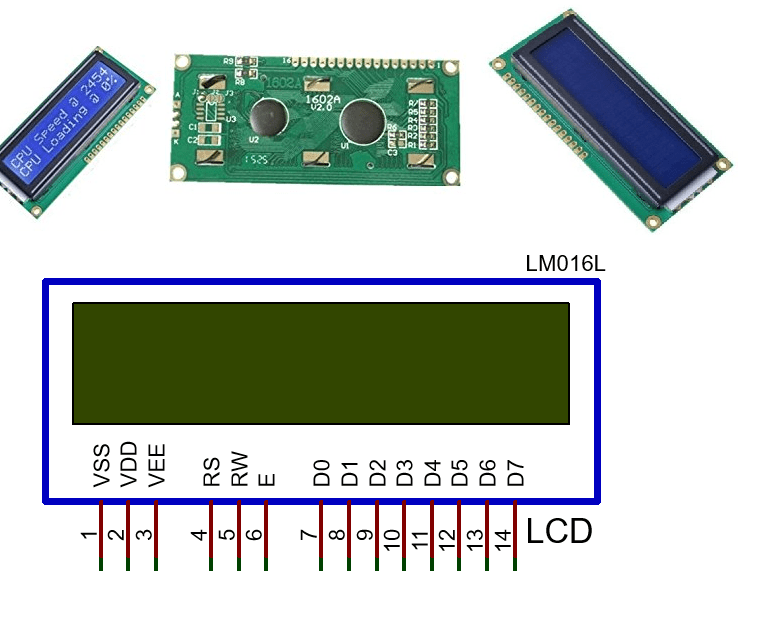
| Pin No. | Name | Description |
| Pin no. 1 | VSS | Masse alimentation (GND) |
| Pin no. 2 | VCC | Alimentation (+5V) |
| Pin no. 3 | VEE | Ajustement de la contraste |
| RS | 0 = Entrée instruction 1 = Entrée données |
|
| Pin no. 5 | R/W | 0 = Ecrire sur LCD 1 = Lire l’afficheur LCD |
| Pin no. 6 | EN | Signal d’activation |
| Pin no. 7 | D0 | Donnée ligne 0 (LSB) |
| Pin no. 8 | D1 | Donnée ligne 1 |
| Pin no. 9 | D2 | Donnée ligne 2 |
| Pin no. 10 | D3 | Donnée ligne 3 |
| Pin no. 11 | D4 | Donnée ligne 4 |
| Pin no. 12 | D5 | Donnée ligne 5 |
| Pin no. 13 | D6 | Donnée ligne 6 |
| Pin no. 14 | D7 | Donnée ligne 7 (MSB) |
La tension VEE permet d’ajuster le contraste du LCD. On peut utiliser un potentiomètre branché avec une alimentation 5V afin de régler l’éclairage de l’afficheur. Pour des raisons de simplification, nous avons branché le pin VEE avec une alimentation 5V fixe.
Afficheur LCD 12×2 LM016L (Fonctions de contrôle)
Le mikroC PRO for PIC fournit une bibliothèque pour la communication avec les écrans à cristaux liquides via l’interface 4 bits (D4-D7. Un exemple de connexions LCD est donné dans le schéma de principe illustré au début du projet. Le logiciel MikroC dispose de six fonctions et un ensemble de variables internes pour la manipulation de ‘afficheur LCD.
Lcd_Init()
Initialisation de l’écran LCD. La fonction ne dispose pas des variables d’entrées ou des sorties. Elle nécessite la déclaration des variables des données et des directions avant son utilisation.
Lcd_Out()
- row: Numéro de ligne (1 ou 2 dans notre cas, la valeur peut être importante lorsqu’on utilise un LCD 4×16, …)
- column: Numéro de la colonne dont on souhaite commencer. La valeur peut varier entre 1 et 16.
- *text: Pointeur du tableau des caractères.
Lcd_Out_Cp()
Afficher le texte dans la position actuelle du curseur.
Lcd_Chr()
Affichage d’un seul caractère dans une position (ligne, colonne) dans l’afficheur LCD.
- Row: Ligne
- Column: Colonne
- out_char: Caractère unique (pas une chaîne de caractères! )
Lcd_Chr_Cp()
Afficher un caractère das la position actuelle du curseur.
Lcd_Cmd()
Envoyer une commande prédéfinie à l’afficheur LCD. Ci-dessous une liste exhaustive des commandes (voir MikroC LCD pour plus de détails)
| Lcd Command | Purpose |
|---|---|
| _LCD_FIRST_ROW | Move cursor to the 1st row |
| _LCD_SECOND_ROW | Move cursor to the 2nd row |
| _LCD_THIRD_ROW | Move cursor to the 3rd row |
| _LCD_FOURTH_ROW | Move cursor to the 4th row |
| _LCD_CLEAR | Clear display |
| _LCD_RETURN_HOME | Return cursor to home position, returns a shifted display to its original position. Display data RAM is unaffected. |
| _LCD_CURSOR_OFF | Turn off cursor |
| _LCD_UNDERLINE_ON | Underline cursor on |
| _LCD_BLINK_CURSOR_ON | Blink cursor on |
| _LCD_MOVE_CURSOR_LEFT | Move cursor left without changing display data RAM |
| _LCD_MOVE_CURSOR_RIGHT | Move cursor right without changing display data RAM |
| _LCD_TURN_ON | Turn Lcd display on |
| _LCD_TURN_OFF | Turn Lcd display off |
| _LCD_SHIFT_LEFT | Shift display left without changing display data RAM |
| _LCD_SHIFT_RIGHT | Shift display right without changing display data RAM |
Comment convertir un entier en chaîne de caractères ?
Paramètres de l’entrée: La fonction a besoin de deux paramètres
- Fnum: La valeur flottante
- Str: Chaîne de caractères (str doit être déclaré comme tableau ou pointeur)
Paramètre de sortie: La fonction renvoie une valeur en format unsigned char qui peut prendre l’un des quatre valeurs suivantes :
- 3 si l’entrée est NaN
- 2 if si l’entrée est -INF
- 1 si l’entrée est +INF
- 0 if Conversion réussie
Comment calculer la tension en fonction des états des entrées A1-A8 ?
Le programme à besoin de trois paramètres pour effectuer le calcul de la tension de sortie : La valeur de la résistance R5 en Ohm, la valeur courant LSB I0_LSB en ampère calculée d’avance (voir le début du projet) et la valeur du DAC. Ci-dessous les lignes de code qui le permet :
Note : La valeur du DAC est initialisée à « 1 ». Elle sera mise à jour lorsqu’on appuie sur l’un des boutons poussoirs (V+ : Incrémentation de la valeur, V- : Décrémentation). .

